Prairie historian Adrian Paton hosted a unique commemoration at his Arcola-area farm on Saturday July 30, as over 100 family members and friends gathered for a 'Legacy of the Land' ceremony.
Paton and his late wife, Pat purchased the land in 1959 and there, they farmed and raised their family of four - sons Rus, Brad and Kevin, and daughter, Val.
The “tribute to the land and its people” took place on Hawk Hill, which is located on the Paton farm, and although Paton unveiled a plaque which marked his family's life on the farm, he also paid tribute to all of the land's past inhabitants during a speech.
“The spot on earth that I call 'Hawk Hill' has been around since the beginning,” says Paton. “Some geologists believe that Precambrian rock was formed at least 1.8 to 2.5 billion years before the present, a span of time that few of us humans can comprehend.”
“Archeologists now believe that man made an appearance here about 20,000 years ago. In this area, they evolved into what are called First Nations people. Their reign lasted a few thousand years. I farmed this land for over 50 years and have found ample evidence of their occupation...”
“Then other people arrived, the Europeans, who molded things to suit their culture,” he adds. “The land had to be laid out in such a way that ownership could be designated. By this time, a body called the Canadian government was in charge. They sent out people called surveyors to do this job. Around 1881, they completed this and the land was given the title of the North West Quarter of Section 17, Township 7, Range 4, West of the second meridian.”
“The (Canadian Pacific Railway) put the land up for sale and an American entrepreneur homesteader Charles Watkins bought the land on speculation.”
Paton states that Watkins, his wife Emily, and their three children left their home in Nebraska in the spring of 1901 “in true pioneer fashion,” adding that three weeks after leaving Nebraska, they arrived in Arcola, District of Assiniboia, N.W.T., in June, 1901.
Watkins sold the land in 1909 to William Elwood, who farmed the land “under the fashion of the British system” with his two sons. After William's death in 1930, his sons Harrison and Wilfred (Cap) farmed there until 1959, when they sold the farm to the Patons.
“For the next 50 or more years, I farmed this land,” says Paton. “This hill intrigued me in many ways and over the years, I began to develop a relationship with the land and nature.”
Paton says the name “Hawk Hill” was the direct result of his personal experience on the land.
“One constant that made an impression on me was that whenever I worked near the hill, there was at least one pair of hawks that patrolled a large area.”
“One evening at just about dusk, as I was about to leave the field, a light-coloured hawk landed on top of the hill,” he adds. “When I returned the next morning, I found the hawk dead on the hill. On close examination, I concluded that he was very old as he had almost no meat on his bones and his light colour I think, was due to age.”
“I buried him on top of the hill,” says Paton. “I hope his soul soars aloft and that his descendants continue to patrol the skies above the hill into eternity.”
As a steward of the land, Paton worked hard to balance both the agricultural and ecological aspects of what he sees as “a great responsibility.”
“In the 1980s, I decided I would try to do something for the land, as it was being damaged by wind erosion,” he explains. “With the help of conservation agencies, botanist Nora Stewart, and others, I undertook to establish native vegetation onto the hill.”
“We seeded over 80 species. Many have survived and flourished. We started with over two test plots and later seeded 20 acres and decided to erect a stone cairn, somewhat similar to stone monuments erected on hilltops by early civilizations all over the world.”
The cairn, which is now over 10-feet high, was made even larger as family and friends in attendance added stones they had brought, many of them painted or bearing messages.
That day, Val (Paton) Guillemin said of her father: “This hill and this ceremony represents my father's love for nature and history, a respect for the land; an understanding of the earliest inhabitants - both Indigenous peoples and settlers - and the farming community and a love of friends and family.”
Paton said: “I leave all of this as a tribute to the land and its people. I hope future generations will treat it with the love and respect it deserves.”




